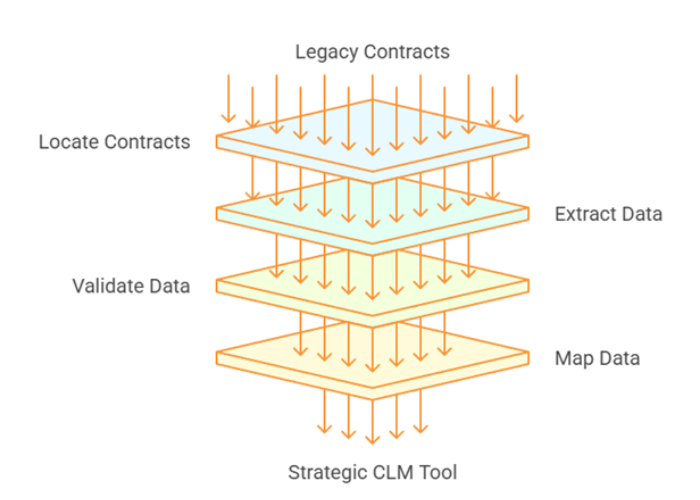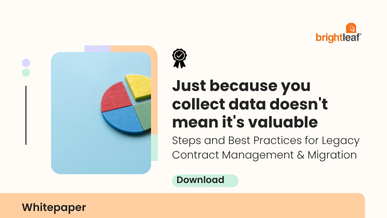Migrating your organization’s legacy contracts into a modern CLM system isn’t just a lift-and-shift project; it’s where transformation can stall or scale. It’s a pivotal initiative that blends technical execution with people-centered change, and success depends on getting both right.
In this blog, we’ll unpack:
- What contract migration entails
- Why it often feels like a tech-heavy project
- How change management shapes long-term outcomes
- Key risks to watch
- A step-by-step strategy for seamless migration
Why Contract Migration Is More Than Uploading Files
Contract migration isn’t just about transferring files; it’s about turning contract chaos into structured, searchable data that drives smarter decisions.
The process starts with locating legacy contracts, often buried in shared drives, emails, or even physical filing cabinets. But uploading PDFs is only the beginning.
Contracts come with:
- Multiple versions (some signed, some not)
- Scanned files without searchable text
- Inconsistent structures and scattered side agreements
At the heart of it all is contract data extraction – pulling key metadata like party names, effective dates, renewal terms, obligations, etc. This transforms static files into actionable data.
Another foundational step is digitization. Physical contracts must be scanned and OCR (optical character recognition) applied, making them text-searchable in your CLM. Then comes standardizing metadata and linking it to the correct documents and accounts.
Without structured metadata and searchable text, your CLM becomes just a digital cabinet- not a strategic system.
When done right, contract migration lays the groundwork for automation, compliance, and better decision-making.
Legacy Contract Migration vs. New System Onboarding
There’s often confusion between legacy contract migration and setting up a new CLM for future use. They are closely related but require different strategies.
Legacy migration focuses on cleaning up the past. It involves locating contracts from fragmented sources, extracting and validating key data points, and mapping that information into your CLM system. The goal is to preserve institutional knowledge and ensure nothing important gets lost in the shuffle.
In contrast, new onboarding is all about the future. It means designing standardized templates, defining metadata structures, and creating automated workflows for new contracts. This helps establish better processes moving forward.
Both are essential, but they require different strategies.
And no matter the phase, data extraction remains the backbone. Without it, your CLM won’t be able to categorize, filter, or trigger workflows.
Contract Migration Process Funnel

Why Contract Migration Feels Like a Tech Project
Contract migration often feels like a technology initiative because of all the infrastructure, coordination, and system integrations involved. You’re not just moving contracts, you’re setting up security protocols, configuring software, connecting platforms, and ensuring metadata is consistent across systems. It involves OCR to turn scanned documents into text-searchable files, integrations with your CRM or ERP systems, and mapping outdated fields to your new metadata structure. It’s highly technical, often requiring dedicated IT support, vendor involvement, and legal tech expertise.
And yet, despite all this technical rigor, migration isn’t just about systems. If you don’t consider the people and processes behind the tech, even the best-executed migration won’t stick.
- Configuring environments involves setting up the secure infrastructure that supports document upload, searchability, and compliance.
- Data structuring and mapping is the behind-the-scenes work that ensures your new CLM can understand, categorize, and act on imported information.
- OCR and digitization are foundational for unlocking information from scanned documents, making them usable in workflows and reporting.
While all of this feels like a tech rollout, successful migration also requires human decisions and organizational alignment.
Why Change Management Makes or Breaks It
Buying the tech is the easy part. Planning, aligning, and preparing people is where real transformation happens. And while it may not be the most glamorous phase of your project, it’s the one that separates CLM wins from wasted investments.
Even the most technically sound migration can fail if people don’t adopt the new system. Change management ensures your investment pays off by aligning people, processes, and expectations.
- Stakeholder Alignment Rolling out a CLM means multiple teams- Legal, Procurement, Sales, IT must coordinate on new workflows. Change management brings these groups together early, sets shared priorities, and assigns clear ownership so everyone knows their role.
- Overcoming Resistance: New systems can trigger anxiety. People fear added complexity or losing control over their work. Proactive communication, early involvement, and personalized training help reduce resistance and build trust in the new system.
- Clarifying Policies and Workflows: A CLM changes how contracts are created, reviewed, and approved. Change management helps define new policies: who initiates a contract, what approvals are needed, and how exceptions are handled. These clarifications prevent confusion and support adoption.
- Highlighting Risks of Inaction: If users don’t engage, the cost can be high: missed renewals, fragmented records, and failed audits. Change management makes these risks visible, helping stakeholders understand that inaction comes at a real price.
- Creating a Culture of Accountability: Adoption isn’t a one-time event. Ongoing communication, performance tracking, and celebrating team champions keep the system embedded into everyday work. Accountability ensures continued engagement and ROI.
Change management turns a system deployment into long-term organizational success. Without it, your CLM may launch but never take off.
Contract Migration Challenges to Watch For
Even the most strategic migration plan comes with challenges. Some of the most common issues include incomplete or inconsistent metadata, lost side agreements, or simply not knowing where all contracts are stored. Sometimes, entire departments use unofficial systems like spreadsheets or shared drives that hold vital contract data.
Migration can also feel overwhelming due to the sheer volume of documents. If you’re dealing with tens of thousands of contracts, it’s tempting to migrate everything at once, but that approach often leads to errors and confusion.
Instead, consider:
- Starting with a pre-migration audit to identify gaps like missing effective dates or renewal terms.
- Tracing back addendums and side agreements that may live in emails or as separate files.
- Mapping unofficial systems like spreadsheets or rogue folders into the official project scope.
- Migrating in waves, beginning with high-value or high-risk contracts.
A little foresight here saves a lot of cleanups later.
Before You Begin: Download the Complete Migration Blueprint
To truly succeed in your legacy contract migration journey, you need more than just a roadmap; you need a proven framework. That’s why we created the whitepaper: “Steps and Best Practices for Legacy Contract Management & Migration.”
Download the full whitepaper here to get the detailed strategies and checklists before investing time, money, and resources.
Final Thoughts: The Real Migration Equation
Contract migration isn’t a tech project alone, and it’s not just a change management initiative either. It’s the intersection of both.
- The tech side ensures clean data, automation, and system functionality
- The people side ensures adoption, compliance, and lasting value
When the systems and the stakeholders move together, CLM becomes a powerful tool, not just a digital archive. Treat contract migration as a strategic initiative, not an afterthought. That’s where true operational transformation begins.

